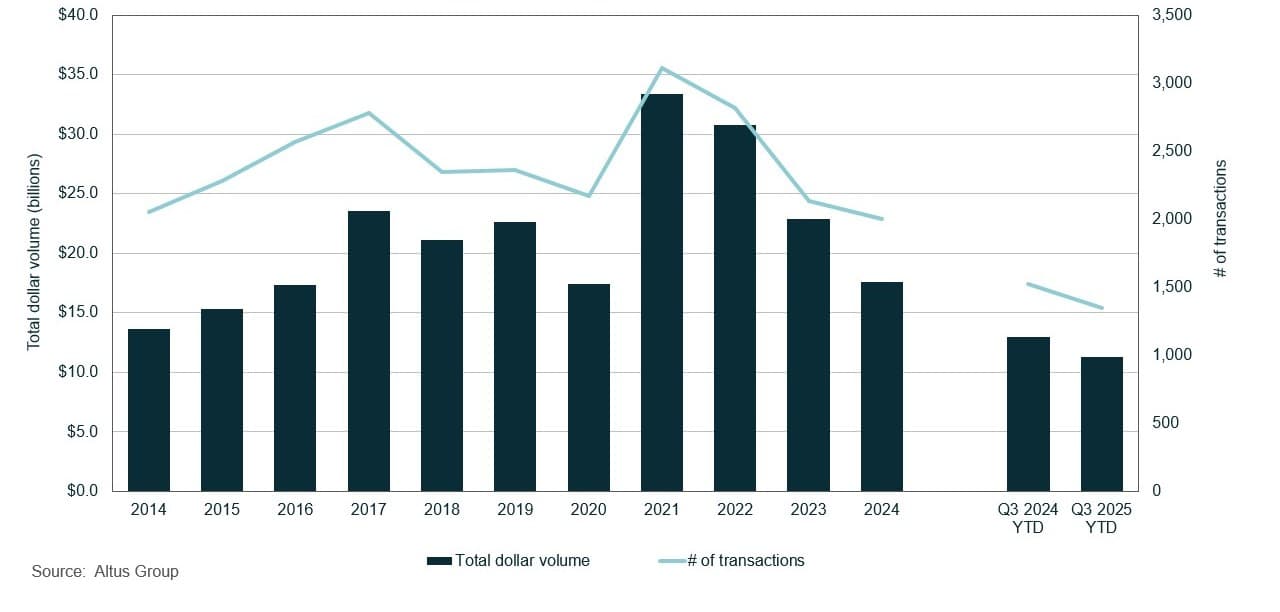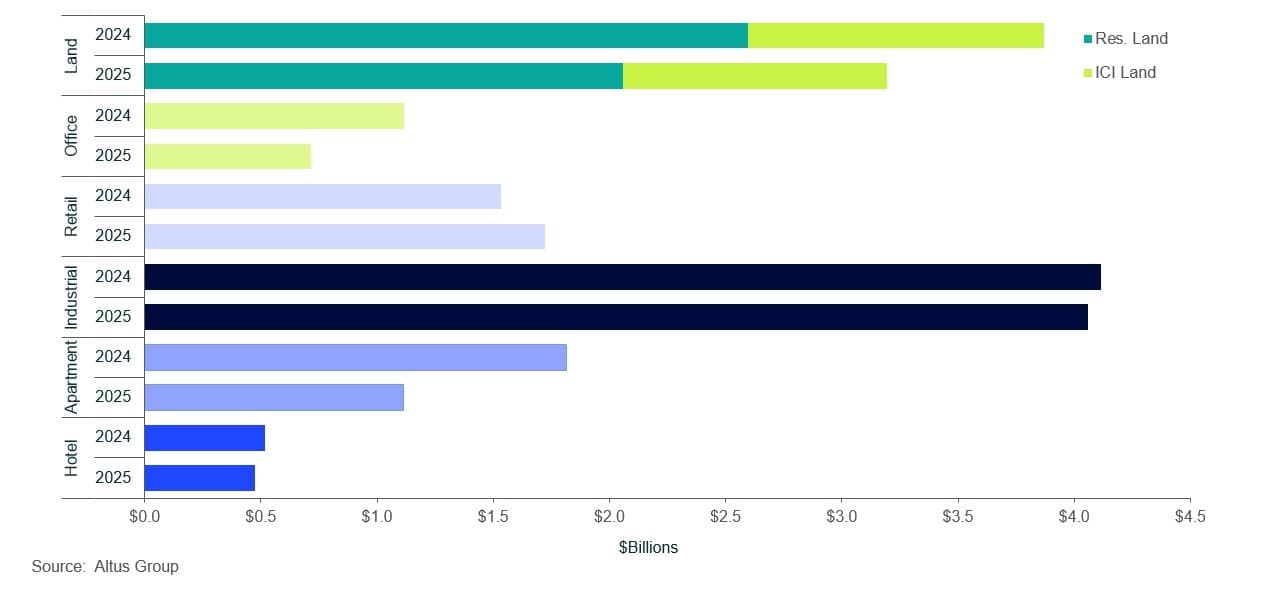Toronto commercial market update - Q3 2025
Toronto’s CRE market softened in Q3 2025 as investment volume fell 13%, with retail resilient and office, land, and multifamily sectors slowing.

Key highlights:
By the close of the third quarter, the Greater Toronto Area reported nearly $11.3 billion in dollar volume transacted, a 13% decline year-over-year
The retail sector remained resilient, up 12% year-over-year to $1.7 billion transacted, as investors favoured food-anchored retail properties and shopping centres with redevelopment opportunities
The industrial sector recorded $4.1 billion transacted, virtually unchanged from last year, as the imposition of US tariffs impacted investor confidence and delayed capital deployment
The multifamily sector saw $1.1 billion transacted, down 38% year-over-year
The office sector continued on a downward trajectory, with $716 million transacted and activity skewed towards Class A office space
The land sector recorded $3.2 billion transacted, marking an 18% year-over-year decrease
The residential land and lots sector recorded $2 billion transacted, while the ICI land sector recorded $1.1 million, down 21% and 11% year-over-year, respectively
By the close of the third quarter, commercial investment in the Greater Toronto Area contracted 13% year-over-year
The Greater Toronto Area (GTA) commercial real estate market experienced a notable slowdown in investment activity by the third quarter of 2025, with the total dollar volume transacted reaching nearly $11.3 billion (Figure 1). This figure represented a 13% decrease from the same period last year.
Figure 1: Greater Toronto Area property transactions - All sectors by year

One primary factor behind the decline was a pull-forward of investment activity in the second quarter of 2024. The anticipation of a proposed increase in the now-cancelled capital gains inclusion rate prompted investors to finalize deals ahead of its planned implementation. This reactive surge created an anomalous spike, making the year-over-year comparison for the first half of 2025 appear disproportionately subdued, as the earlier volume was not indicative of underlying market strength. Persistent investor uncertainty, driven primarily by ongoing geopolitical tensions with the US and a perceived deterioration of Canada’s economic outlook, also contributed to the slowdown. This uncertainty did not signal a lack of interest. Instead, it prompted a deployment pause, leading to a substantial accumulation of institutional capital on the sidelines as investors awaited clearer economic and interest rate signals.
Monetary policy and investment strategy shifts
This sustained lack of business investment activity and deterioration of consumer confidence influenced the Bank of Canada (BoC), which responded by reducing the key overnight rate by 25 basis points to 2.50% on September 17, 2025. This action effectively restarted the easing cycle that began in 2024 and was aimed at better balancing risk within the BoC’s monetary policy framework. The BoC’s decision was prompted by several key economic indicators:
The labour market deteriorated as the national unemployment rate held at 7.1%, signalling diminished labour demand
The country’s Gross Domestic Product (GDP) contracted by 0.4% from Q1 to Q2, primarily due to a significant decline in exports
An upward trend was observed as the Consumer Price Index (CPI) increased to 2.4% in September from 1.9% in August, indicating persistent cost pressures
In response to the prevailing market environment, some investors postponed major investment decisions. In contrast, others reallocated their portfolios, focusing on more resilient asset classes perceived as less susceptible to market fluctuations. A segment of investors also actively pursued opportunities in more affordable regions, diversifying their holdings away from the historically higher-priced GTA market in pursuit of better value and mitigated risk. Consequently, the GTA’s standing in the national investment landscape softened, as according to the latest Altus Group Investment Trends Survey (ITS), the GTA dropped from third place to fourth place compared to Q2, edged out by Quebec City.
Retail investment activity
The retail sector displayed notable resilience by the third quarter, recording $1.7 billion in transaction volume, up 12% year-over-year. However, this masked a tapering of activity that began in the second quarter of 2025 as the sector faced rising external pressures, including escalating trade tensions with the US, which disrupted supply chains and dampened consumer demand, as well as the persistently high cost of capital. Despite these headwinds, the sector benefitted from sustained investor interest in its defensive qualities, notably driven by intense demand for food-anchored retail properties.
These essential service properties were highly valued as an inflation hedge due to their higher occupancy rates, lower tenant turnover, e-commerce resistance, and relative immunity to broader economic fluctuations. This elevated demand exacerbated an existing inventory shortage, as owners were retaining these valuable, income-producing assets, while limited lending and high cost of capital restricted new development. Consequently, near-term investment activity remained constrained by the lack of available products and high financing costs.
Industrial investment activity
The industrial sector recorded nearly $4.1 billion in dollar volume transacted, a negligible 1% year-over-year decrease. This plateau was primarily driven by sustained investor caution amid uncertainty surrounding global trade policy and the persistently high cost of capital, which together curtailed acquisition activity.
The GTA continued to navigate a rebalancing of supply and demand dynamics, as the Canadian industrial market update reported that Toronto’s industrial availability rate decreased by 60 basis points year-over-year, reaching 4.8%. Moreover, net absorption swung back into positive territory during the third quarter, signalling renewed, albeit selective, demand for existing industrial space. Crucially, the market experienced a bifurcation in demand: the combined effect of increased total supply and subdued leasing on new product provided occupiers with greater leverage, resulting in more flexibility and favourable lease economics across the market, forcing property owners to offer concessions to secure tenants.
Furthermore, the market recorded a significant injection of new supply, adding approximately 1.5 million square feet, of which 84% remained available for lease, indicating a pullback in pre-leasing activity on new construction as market demand waned. The construction pipeline observed a slight uptick, with 10.3 million square feet under construction, of which 78% was still available for lease. This suggests that the market could continue to experience elevated availability rates as these projects reach completion. Despite the challenging operating environment and the short-term supply-side pressures, the long-term fundamentals in the GTA remained attractive. The region’s strategic location, dense population base, and high demand for e-commerce and logistics infrastructure continued to underpin its strength.
Multifamily investment activity
The multifamily sector recorded $1.1 billion in dollar volume, a year-over-year decrease of 38%. This decline was attributed to several factors, including the high cost of capital and overall economic uncertainty. The GTA’s condominium market experienced low sales volume due to misalignment between pricing and buyers’ expectations, creating a mounting oversupply of available units. This oversupply placed downward pressure on the prices and rents of new units, indirectly affecting the broader multifamily sector by increasing the number of rental options. Compounding these difficulties, the persistent housing affordability crisis exerted widespread influence on prospective buyers. Elevated homeownership costs continued to exclude many potential first-time buyers, redirecting a substantial portion towards rental accommodation. Nonetheless, the substantial volume of new condominium supply created a more challenging environment for landlords, diminishing both rental income stability and the likelihood of continual capital appreciation. This escalated risk, together with increased carrying costs for investors, resulted in a cautious stance, prompting investors to refrain from immediate acquisitions.
Office investment activity
The office sector experienced a significant decline in investment volume, with our latest Canadian office market update reporting that the dollar volume transacted reached a low of $716 million, down 36% year-over-year. The majority of investment activity was concentrated within the Class A office space segment, as improving tenant demand and office utilization rates within this segment indicated a flight-to-quality amid evolving workplace preferences and return-to-office mandates.
One driver of occupancy shifts, particularly in the downtown core, was the implementation of stricter return-to-office mandates. Several major financial institutions in Canada, along with the Government of Ontario, have mandated that their employees return to a four-day, in-office work week. The Government of Ontario planned to implement this change in phases; employees were initially required to adopt a four-day in-office schedule starting in October 2025, with a subsequent transition to a five-day, in-office work week scheduled for January 2026. This rapid shift drew significant internal and public criticism in some organizations. The abrupt increase in daily in-office population exposed capacity issues in some offices, which led to employees being forced to work out of cafeterias and other common spaces. This overflow of personnel into non-dedicated workplaces was reported to compromise both productivity and employee well-being, highlighting the operational challenges of quickly adjusting physical infrastructure to meet mandated, high-density occupancy levels.
This renewed focus on in-office work contributed to a tightening of Class A space, as evidenced by the downtown Class A availability rate, which dropped by 370 basis points year-over-year to 14.9%. Furthermore, the downtown Class A sublet availability rate declined by 170 basis points to 2.9%. Leasing activity during the quarter corroborated this preference for premium assets. Class A office transactions accounted for 136 deals, totalling nearly 5.3 million square feet of space leased. In stark contrast, Class B office space comprised only 34 transactions, totalling approximately 811,000 square feet, underscoring the bifurcation in tenant demand as older, functionally obsolete buildings no longer meet the demands of modern businesses and workers.
On the development front, the third quarter recorded no new office completions. The GTA still had over two million square feet of office space under construction. Of this future supply, 26% was available for lease, suggesting continued demand for new, modern office accommodations. These projects were being developed to meet evolving tenant requirements, specifically those prioritizing collaboration spaces, integrated technology, and employee well-being amenities. The prevailing challenge for the market remained the need to balance this new incoming supply with the broader, ongoing shifts in overall office utilization patterns.
Land investment activity
The land sector, encompassing both residential and ICI land, experienced a significant contraction in investment activity. The total transaction volume by the end of the third quarter of 2025 reached approximately $3.2 billion, representing an 18% year-over-year decrease. The residential land and lots sector bore the brunt of this downturn, with transaction volumes totalling over $2 billion, a 21% year-over-year decrease. Similarly, the ICI land sector recorded approximately $1.1 billion in dollar volume transacted, representing an 11% decrease. This overall decline indicated a broad-based hesitation among developers in pursuing both residential and commercial development plans.
Developers continued to postpone commitments to new projects amid market uncertainty and restrictive lending conditions. A driver of this hesitation was the impact of Canada’s retaliatory tariffs against the US on a substantial volume of goods. While the Government of Canada announced in August 2025 the removal of counter-tariffs on most US goods covered under CUSMA, effective September 1, 2025, a key exception remained. Tariffs on non-CUSMA-compliant goods such as steel, aluminum, and HVAC equipment continued to drive up the cost of critical building materials, thus eroding project viability and amplifying the financial risks of long-term land acquisition and development. The decision to delay new acquisitions was a strategic reassessment in response to these volatile economic conditions.
Figure 2: Greater Toronto Area property transactions by asset class (2024 vs. 2025)

Notable Toronto property transactions
The following are the notable transactions for the Q3 2025 Toronto commercial real estate market update:
Rockwood Mall (4141 Dixie Road) – Retail
The largest retail transaction recorded during the third quarter involved the acquisition of Rockwood Mall by BGO. BGO purchased the shopping centre, situated at 4141 Dixie Road in Mississauga, from The Sitzer and Salpam Investments for a price of $90 million. The 303,000 square foot property was approximately 95% occupied at the time of sale. Constructed in 1970, the shopping centre sits on a 23.7-acre site, a substantial land parcel which presented long-term redevelopment potential. This acquisition aligned with BGO’s Prime Canadian Property Strategy, which prioritized high-performing retail assets situated in major urban markets.
Gateway Distribution Centre (11400 Steeles Avenue East) – Industrial
BGO further expanded its portfolio with the purchase of the Gateway Distribution Centre, located at 11400 Steeles Avenue East in Halton Hills, for $143 million from I.G Investment Management. The almost 640,000 square foot building was situated on 33.5 acres along the critical Highway 401 corridor and had been constructed by Broccolini in 2016. The property featured modern logistics specifications, including 36-foot clear heights, designed to accommodate large-scale logistics and e-commerce tenants. At the time of sale, the property was fully leased by Relay Logistics and Speedy Transport. Its strategic location and modern design firmly established the facility as one of the GTA’s most desirable modern distribution centres.
740 Dupont Street – Apartment
In the purpose-built rental sector, LaSalle Investment Management acquired the newly constructed Litho Residences at 740 Dupont Street from RioCan REIT and Woodbourne for $152.4 million. The eight-storey, 210-unit multifamily property set a benchmark for the year, achieving the highest total sale price and price per unit ($725,714) among all GTA high-rise apartment transactions to date. Completed in 2021, the mixed-use development included ground-floor retail and offered luxury amenities such as a fitness studio, co-working space, and a rooftop terrace. The transaction, brokered by CBRE, highlighted robust investor confidence in Toronto’s purpose-built rental sector.
10378 Highway 48 – Residential land
In the land sector, Greybrook Realty Partners and Fieldgate Homes jointly acquired a 104-acre parcel at Highway 48 and Major Mackenzie Drive East in Markham for $54.3 million. With approximately 45 projected net developable acres, the site was slated for a future mixed-use residential development designed to add over 420 single-detached homes and townhomes to the northeastern part of Markham. The property’s location within the former Greenbelt lands underscores a renewed trend of development activity following recent provincial policy revisions, which aimed to expedite the delivery of new housing supply.
Figure 3: Greater Toronto Area OCR trends across 4 benchmark asset classes

Looking ahead
The first three quarters of 2025 were a period of pronounced capital recalibration in the GTA’s commercial real estate market, characterized by subdued overall investment volume and a clear bifurcation of performance across multiple sectors. While the market contended with the persistent macroeconomic uncertainties, the BoC’s rate cut in September signaled a shift in monetary policy aimed at mitigating risk and restarting business investment activity. This move, combined with selective market strength in asset classes like food-anchored retail and Class A office space, indicated that the foundation for a more rationalized market is being established.
Looking ahead, the market’s trajectory will hinge on the stability of the economic and geopolitical environment. Capital remains substantially on the sidelines, and a consistent easing of interest rates, coupled with greater clarity on Canada-US trade policies, is anticipated to unlock this pent-up demand, likely driving investment volumes higher. However, this recovery is expected to be uneven. The industrial sector will likely continue its period of normalization, with elevated availability rates persisting as significant new supply is absorbed, leading to sustained pressure on rent growth and increased leverage on tenants. Conversely, the “flight-to-quality” trend is expected to intensify in the office sector, creating a widening performance gap where modern, well-located, amenity-rich Class A assets continue to attract investment and command higher occupancy, while the older stock faces increasing obsolescence. Overall, the market is transitioning from a period of acute uncertainty to one defined by strategic asset selection, risk mitigation, and a renewed focus on fundamental value, setting the stage for a gradual sector-specific rebound in transactional activity in the near future.
Want to be notified of our new and relevant CRE content, articles and events?
Disclaimer
This publication has been prepared for general guidance on matters of interest only and does not constitute professional advice or services of Altus Group, its affiliates and its related entities (collectively “Altus Group”). You should not act upon the information contained in this publication without obtaining specific professional advice.
A number of factors may influence the performance of the commercial real estate market, including regulatory conditions and economic factors such as interest rate fluctuations, inflation, changing investor sentiment, and shifts in tenant demand or occupancy trends. We strongly recommend that you consult with a qualified professional to assess how these and other market dynamics may impact your investment strategy, underwriting assumptions, asset valuations, and overall portfolio performance.
No representation or warranty (express or implied) is given as to the accuracy, completeness or reliability of the information contained in this publication, or the suitability of the information for a particular purpose. To the extent permitted by law, Altus Group does not accept or assume any liability, responsibility or duty of care for any consequences of you or anyone else acting, or refraining to act, in reliance on the information contained in this publication or for any decision based on it. The distribution of this publication to you does not create, extend or revive a client relationship between Altus Group and you or any other person or entity. This publication, or any part thereof, may not be reproduced or distributed in any form for any purpose without the express written consent of Altus Group.
Authors

Jennifer Nhieu
Senior Research Analyst

Wyland Milborne
Market Analyst
Authors

Jennifer Nhieu
Senior Research Analyst

Wyland Milborne
Market Analyst
Resources
Latest insights





